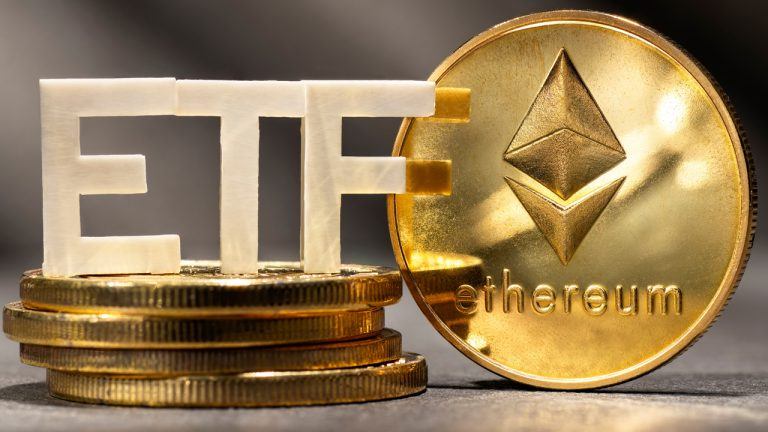 On Friday, U.S. spot ethereum exchange-traded funds (ETFs) faced $54.27 million in outflows, a stark contrast to Thursday’s net inflow of $26.7 million, as indicated by recent data. Meanwhile, Grayscale’s Ethereum Trust (ETHE) has seen a reduction of over $2 billion in ethereum since July 23. U.S. Ether ETFs Shed $54.27 Million on Friday The […]
On Friday, U.S. spot ethereum exchange-traded funds (ETFs) faced $54.27 million in outflows, a stark contrast to Thursday’s net inflow of $26.7 million, as indicated by recent data. Meanwhile, Grayscale’s Ethereum Trust (ETHE) has seen a reduction of over $2 billion in ethereum since July 23. U.S. Ether ETFs Shed $54.27 Million on Friday The […]

Cathie Wood’s ARK has resumed active trading of crypto-related stocks like Coinbase, 3iQ Ether staking ETF, Robinhood and its own spot Bitcoin ETF.
Cryptocurrency-related trades are again gathering steam at Cathie Wood’s investment firm ARK Invest as it returned to trading tens of millions of dollars in crypto-related stocks and exchange-traded funds (ETF) in one day.
After resuming significant sales of Coinbase stock in July, ARK increased it’s sales selling in August, dumping 69,069 Coinbase shares on Aug. 1, according to trading data seen by Cointelegraph. Based on the stock’s closing price, the amount is worth $14.7 million, according to data from TradingView.
The transaction is ARK’s biggest Coinbase sale since early April and late March when the firm dumped around 60,000 Coinbase shares daily.
 Futu Securities International, Hong Kong’s largest online broker with 21.64 million users, has launched retail cryptocurrency trading. Hong Kong residents can now trade bitcoin and ether in either Hong Kong or U.S. dollars directly through Futu’s platform. “We are actively working on expanding our crypto offerings in the near future,” the company said. Last month, […]
Futu Securities International, Hong Kong’s largest online broker with 21.64 million users, has launched retail cryptocurrency trading. Hong Kong residents can now trade bitcoin and ether in either Hong Kong or U.S. dollars directly through Futu’s platform. “We are actively working on expanding our crypto offerings in the near future,” the company said. Last month, […] A survey of 32 cryptocurrency experts on the Finder panel predicts significant growth for ether prices, with average forecasts of $5,368 by the end of 2024, $7,359 by the end of 2025, and $23,549 by 2030. These projections highlight the anticipated impact of institutional factors such as ethereum exchange-traded funds (ETFs). Survey Predicts Strong Future […]
A survey of 32 cryptocurrency experts on the Finder panel predicts significant growth for ether prices, with average forecasts of $5,368 by the end of 2024, $7,359 by the end of 2025, and $23,549 by 2030. These projections highlight the anticipated impact of institutional factors such as ethereum exchange-traded funds (ETFs). Survey Predicts Strong Future […] On Tuesday, U.S. spot ether exchange-traded funds (ETFs) experienced a day of inflows, ending four days of outflows. The nine ETFs collectively absorbed $33.67 million, though the figure could have been higher if not for Grayscale’s Ethereum Trust (ETHE), which offloaded $120.28 million. Ether ETFs Bounce Back After 4-Day Outflows The ether-based ETFs in the […]
On Tuesday, U.S. spot ether exchange-traded funds (ETFs) experienced a day of inflows, ending four days of outflows. The nine ETFs collectively absorbed $33.67 million, though the figure could have been higher if not for Grayscale’s Ethereum Trust (ETHE), which offloaded $120.28 million. Ether ETFs Bounce Back After 4-Day Outflows The ether-based ETFs in the […] Over the past day, the crypto economy has grown by 2.57%, reaching $2.48 trillion on Monday, July 29. Bitcoin has climbed over 3% since last week, while ether has decreased slightly by over 3% during the same period. The highest gainer this week was ecash (XEC), which increased nearly 17% over the past seven days. […]
Over the past day, the crypto economy has grown by 2.57%, reaching $2.48 trillion on Monday, July 29. Bitcoin has climbed over 3% since last week, while ether has decreased slightly by over 3% during the same period. The highest gainer this week was ecash (XEC), which increased nearly 17% over the past seven days. […] According to onchain data, a significant whale holding over 92,500 ether moved the funds to an unidentified wallet. Arkham Intelligence data suggests the funds may have been linked to the Ethereum Foundation, though this is not confirmed. Originally, the funds were transferred to a mysterious wallet on Sept. 1, 2015. Significant Ether Transfer Worth $288M […]
According to onchain data, a significant whale holding over 92,500 ether moved the funds to an unidentified wallet. Arkham Intelligence data suggests the funds may have been linked to the Ethereum Foundation, though this is not confirmed. Originally, the funds were transferred to a mysterious wallet on Sept. 1, 2015. Significant Ether Transfer Worth $288M […] U.S. spot bitcoin exchange-traded funds (ETFs) experienced a downturn on Tuesday, with $77.97 million exiting, breaking a streak of 12 consecutive days of inflows. In contrast, the newly launched spot ether ETF counterparts performed better. 3 Bitcoin ETFs Record Outflows as Blackrock’s IBIT Gains $71M Following 12 consecutive days of inflows and a record influx […]
U.S. spot bitcoin exchange-traded funds (ETFs) experienced a downturn on Tuesday, with $77.97 million exiting, breaking a streak of 12 consecutive days of inflows. In contrast, the newly launched spot ether ETF counterparts performed better. 3 Bitcoin ETFs Record Outflows as Blackrock’s IBIT Gains $71M Following 12 consecutive days of inflows and a record influx […] A managing partner at SEC-regulated Registered Investment Advisor Two Prime has discussed the potential impact of spot ether exchange-traded fund (ETF) launches on the cryptocurrency market. He explained that early demand could be greater than when spot bitcoin ETFs launched and suggested that a sharp uptick in ethereum price from the ether ETFs could lead […]
A managing partner at SEC-regulated Registered Investment Advisor Two Prime has discussed the potential impact of spot ether exchange-traded fund (ETF) launches on the cryptocurrency market. He explained that early demand could be greater than when spot bitcoin ETFs launched and suggested that a sharp uptick in ethereum price from the ether ETFs could lead […] Cboe, the Chicago Board Options Exchange, is preparing to list five new ether exchange-traded funds (ETFs) on Tuesday, pending regulatory effectiveness. These five spot ethereum ETFs are from 21shares, Fidelity, Franklin, Invesco Galaxy, and Vaneck. The U.S. Securities and Exchange Commission (SEC) approved Form 19b-4 filings for eight spot ether ETFs in May and has […]
Cboe, the Chicago Board Options Exchange, is preparing to list five new ether exchange-traded funds (ETFs) on Tuesday, pending regulatory effectiveness. These five spot ethereum ETFs are from 21shares, Fidelity, Franklin, Invesco Galaxy, and Vaneck. The U.S. Securities and Exchange Commission (SEC) approved Form 19b-4 filings for eight spot ether ETFs in May and has […]